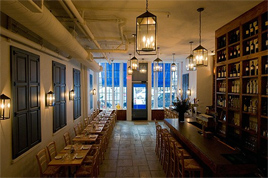

[Kreiger via Eater]
If you’re an ethical food blogger—don’t snicker, that’s not an oxymoron—what do you do when a restaurant in its first week is a disaster? Do you assume the problems will eventually be worked out? Or do you call it like it is?
As of today, the new Kefi is a disaster—a blunder by two smart people who should have known better. The question is, how much can they improve? We figure that Michael Psilakis and Donatella Arpaia—chef and restauranteur respectively—will do their best to get it right. Yet, much of what is wrong stems from a misguided concept that is not easily fixed.
 Let’s be blunt: this is their third restaurant together, and more are coming. Psilakis and Arpaia were both in the house on Saturday night, but that won’t last long. After the critics have come through, they’ll both be spending their time elsewhere.
Let’s be blunt: this is their third restaurant together, and more are coming. Psilakis and Arpaia were both in the house on Saturday night, but that won’t last long. After the critics have come through, they’ll both be spending their time elsewhere.
In at least 10 visits to her various restaurants, this is the first time I’ve ever seen Arpaia. And in my experience, her restaurants do not improve with time. She has too many of them, along with other projects, to give the loving attention they need, and apparently she cannot find, or has not found, the right staff to manage them in her stead.
 Here’s the background: Psilakis opened Onera on the Upper West Side, a Greek take on haute cuisine that critics liked, but wasn’t suited to the neighborhood. He turned it into an inexpensive casual place called Kefi, which didn’t take reservations or even credit cards. Meanwhile, the haute Greek idea was reborn as Anthos in a fancier midtown location, earning a Michelin star in its first year. Those aren’t the only restaurants Psilakis and Arpaia have been involved in, or rumored to be working on, but we’ll leave the history lesson there.
Here’s the background: Psilakis opened Onera on the Upper West Side, a Greek take on haute cuisine that critics liked, but wasn’t suited to the neighborhood. He turned it into an inexpensive casual place called Kefi, which didn’t take reservations or even credit cards. Meanwhile, the haute Greek idea was reborn as Anthos in a fancier midtown location, earning a Michelin star in its first year. Those aren’t the only restaurants Psilakis and Arpaia have been involved in, or rumored to be working on, but we’ll leave the history lesson there.
Kefi was a big hit. We were impressed. So were the critics. Peter Meehan filed a rave in $25 & Under. There was lots of love on the BruniBlog. But Kefi had a problem: it had only 70 seats, and waits to get in were interminable. So Psilakis and Arpaia decided to move several blocks away, where they could triple the space, and where they could finally accept reservations and credit cards.
I appreciate that Psilakis and Arpaia hated turning customers away. Yet, there was a grave risk that, in moving to a space 200% larger, the concept would lose its charm. That is exactly what has happened: stadium dining at its worst. The new Kefi feels like a theater district barn, geared to churn out hundreds of meals at a breakneck pace. The only difference is that Kefi doesn’t slow down at 8:00.
 There are four rooms on two levels, each with its own design personality. (In this, it resembles Mia Dona, another Psilakis/Arpaia property.) This choice was supposed to “keep Kefi’s intimate appeal,” but it doesn’t work that way. The host station is inexplicably near the back of the first floor, so you have to navigate the clotted bar just to ask for your table.
There are four rooms on two levels, each with its own design personality. (In this, it resembles Mia Dona, another Psilakis/Arpaia property.) This choice was supposed to “keep Kefi’s intimate appeal,” but it doesn’t work that way. The host station is inexplicably near the back of the first floor, so you have to navigate the clotted bar just to ask for your table.
This unfortunate intersection is adjacent to the kitchen, so runners with food and busboys with dirty dishes have to fight their way through the same space where diners not yet seated are forced to congregate. Staff and customers must also share a narrow winding staircase that leads to two downstairs dining rooms, and also to the restrooms. Anyone who works here will get plenty of exercise. This restaurant really needed a dumbwaiter.
Our adventure did not start well: they had lost our reservation. “We’ll accommodate you,” our hostess generously offered, after conferring with Ms. Arpaia. A better response might have been, “We apologize for misplacing your reservation.” I know that customers are sometimes mistaken or even deceitful about bookings they claim to have made, but a new and obviously disorganized restaurant might want to consider giving the benefit of the doubt.
Kefi was packed when we arrived, and it was packed when we left. It had the usual problems of a restaurant suddenly serving triple the number of guests. Runners were frequently confused about where to deliver food. This happened not just at our table, but everywhere. Most dishes came out not quite warm enough. This, too, happened repeatedly. Kefi is tightly packed, so it was not difficult to overhear the complaints. Plates were dropped off without silverware. Appetizer plates were cleared while leaving dirty silverware behind.
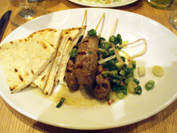
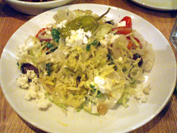

House-made sausage ($7.50; above left) was the best thing we had: tender, a bit spicy, and served at the right temperature. Greek salad ($6.50; above right) was pedestrian. Meatballs ($6.25; above right) had potential, but they were served lukewarm.

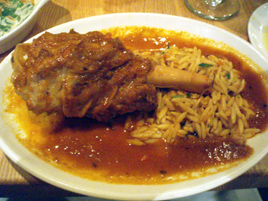
For the main course, I ordered the braised lamb shank ($15.95), as I had done at the former location. The plating last time (above left) is more careful, with the bed of orzo covering the plate and flecks of green on the shank itself. The version of it served on Saturday (above right) was a much lazier try, with the food carelessly dumped on the plate. The lamb shank itself was just fine, but with sufficient brazing any meat naturally would be.
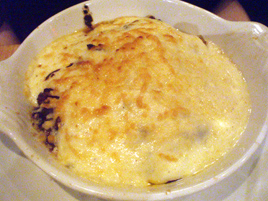

Moussaka ($11.95; above left) and Creamed Spinach ($5.50; above right) were both average. Neither one was served quite warm enough.


Dessert was alleged to be Sesame Sorbet ($3.95; above left), though it sure tasted like ice cream to us. Whatever it was, it was too tart.
If there’s a bright spot at Kefi, it’s the all-Greek wine list. There are tasting notes for each bottle, which is thoughtful of them, as these appellations will be utterly unfamiliar to most diners. Many bottles are very reasonably priced For $48 I was pleased with the 2001 Grande Reserve Naoussa Boutari (above right). If it were French, restaurants would sell it for twice as much.
Prices remain the saving grace at Kefi. We had three appetizers, two entrées, a side dish and a bottle of wine for just $105.60, before tax and tip. That’s a bargain by today’s standards, though it is still no excuse for serving lukewarm food in a charmless atmosphere. The new place still has Kefi’s name, but none of its appeal, other than low prices.
Ms. Arpaia came downstairs multiple times during our visit. But we never noticed her stopping at any table to ask how it was going. “She doesn’t look happy,” my girlfriend said. We passed her coming down as we were leaving. You’d think she might have said, “Thanks for coming.” Naturally, she did not.
Perhaps Psilakis and Arpaia will be able to whip this place into shape, but I doubt it. They have too many other projects, and too many of the problems are design flaws that are virtually impossible to fix. Even if they ace it, this place cannot duplicate the original Kefi’s charms. They should not have sullied its good name.
I am not going to pronounce Kefi a failure after just six nights of service. This chef and this owner have earned the right to prove they can do better. They have their work cut out for them.
Kefi (505 Columbus Avenue between 84th–85th Streets, Upper West Side)
Food: good, when it is served warm enough
Service: confused
Atmosphere: a dining stadium
Overall: incomplete
 Thursday, March 19, 2009 at 10:07AM
Thursday, March 19, 2009 at 10:07AM  Donatella Arpaia,
Donatella Arpaia,  Kefi,
Kefi,  Michael Psilakis in
Michael Psilakis in  BruniBetting
BruniBetting 




















